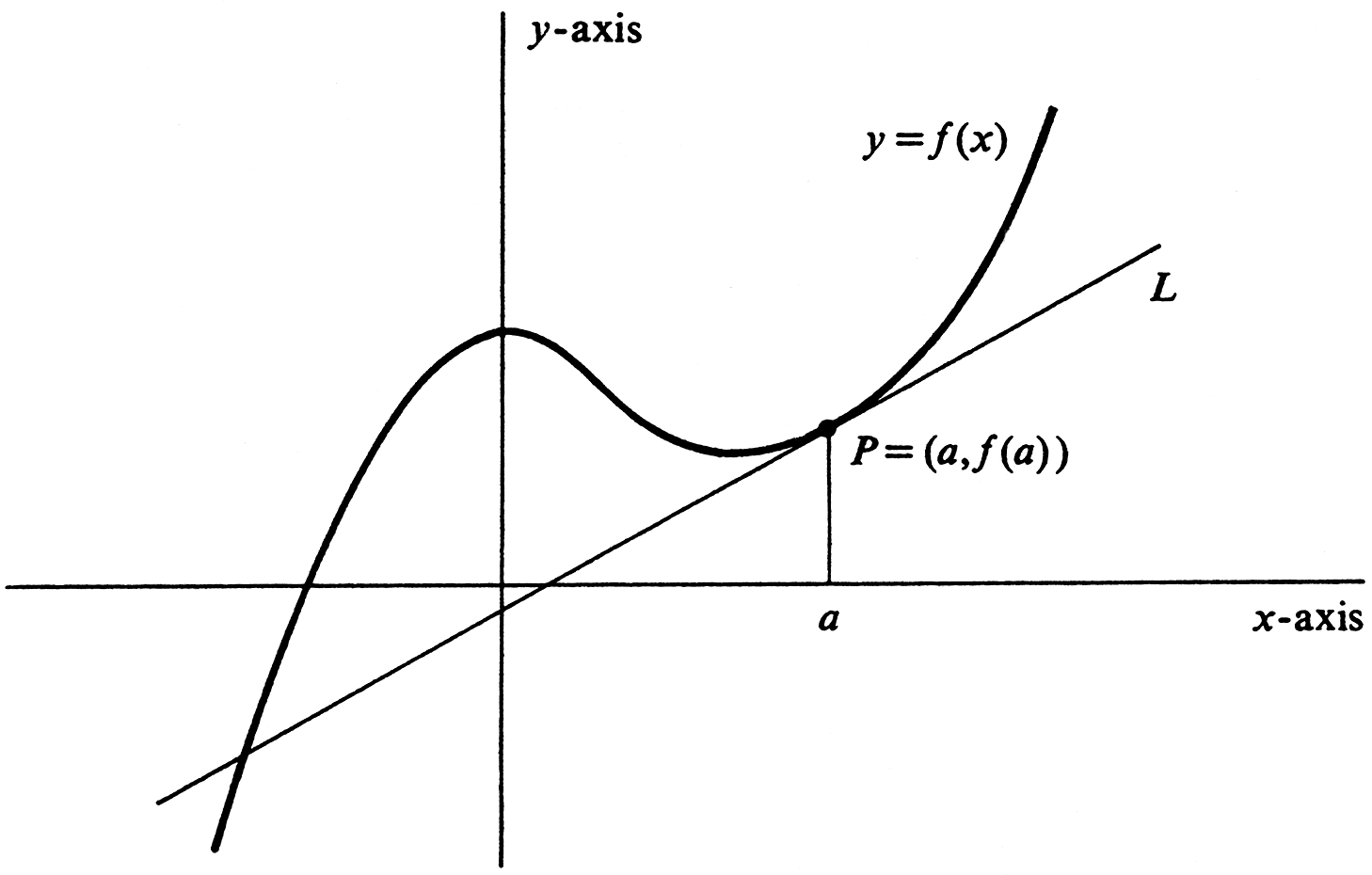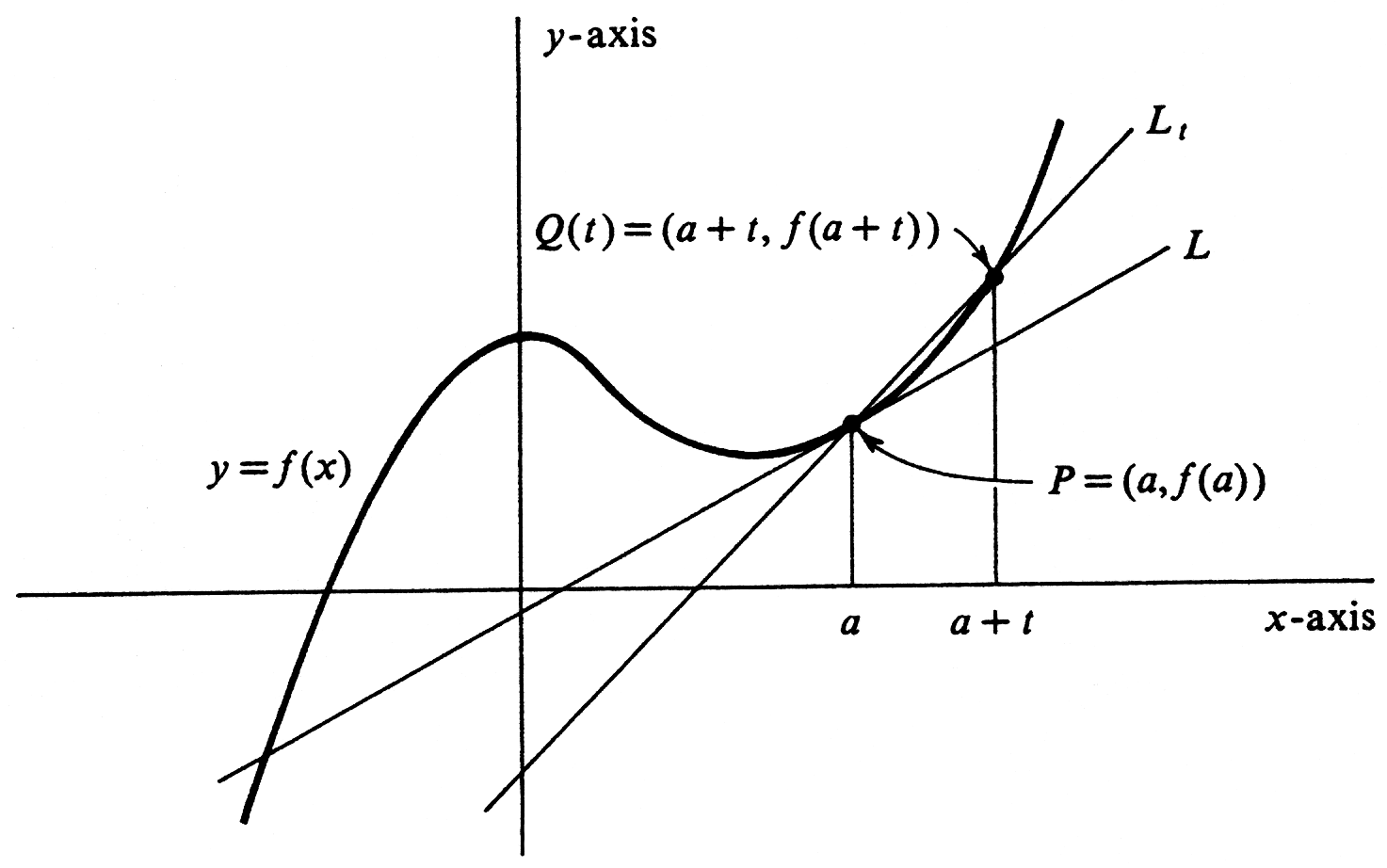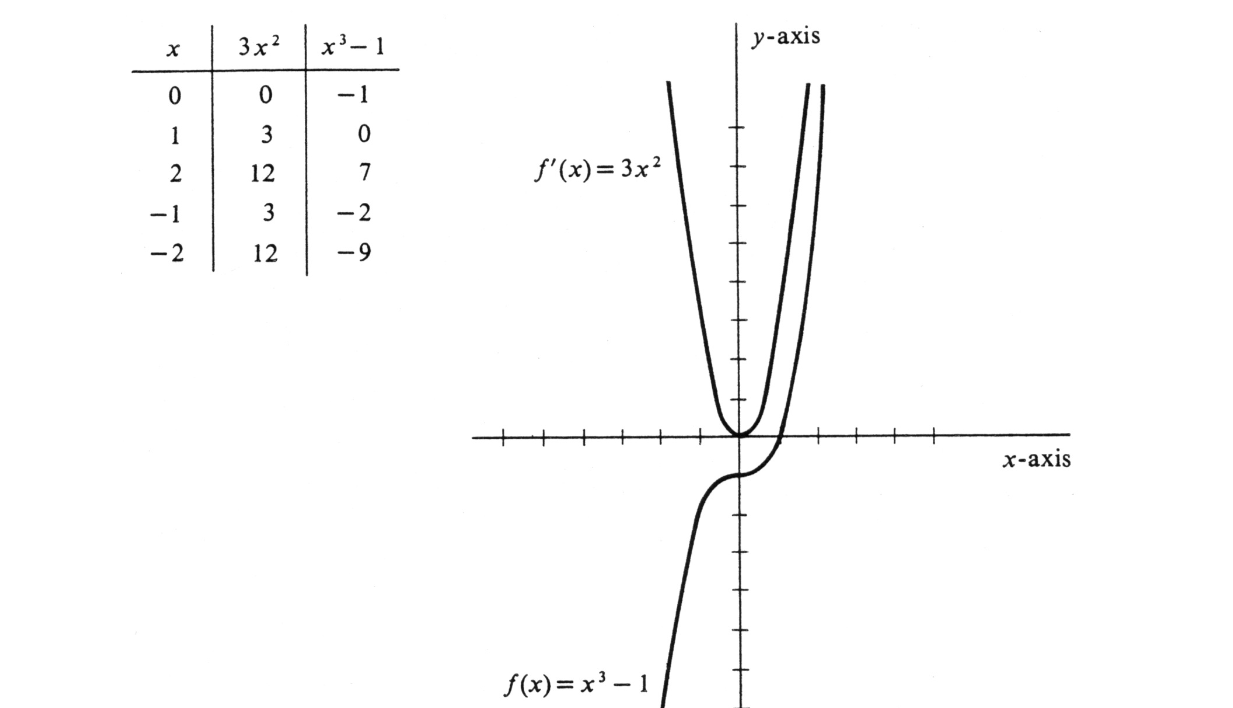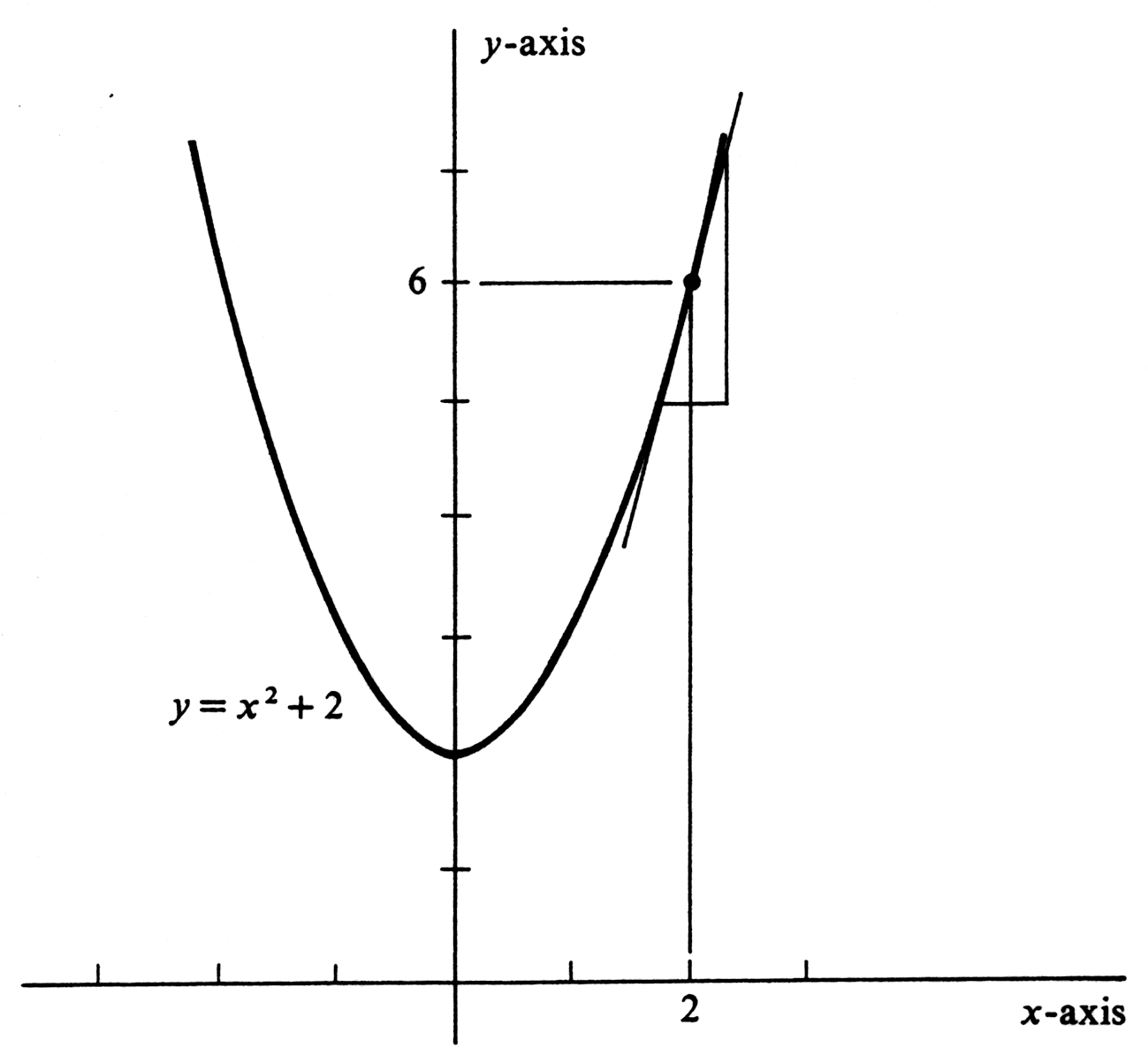guide:A8103d1e65: Difference between revisions
mNo edit summary |
mNo edit summary |
||
| Line 177: | Line 177: | ||
<span id="exam 1.6.2"/> | <span id="exam 1.6.2"/> | ||
'''Example''' | '''Example''' | ||
Consider the function <math>g</math> defined by | Consider the function <math>g</math> defined by | ||
| Line 207: | Line 207: | ||
<span id="exam 1.6.3"/> | <span id="exam 1.6.3"/> | ||
'''Example''' | '''Example''' | ||
Find <math>F'(a)</math>, where <math>a > 0</math> and <math>F</math> is the function | Find <math>F'(a)</math>, where <math>a > 0</math> and <math>F</math> is the function | ||
| Line 307: | Line 307: | ||
</math> | </math> | ||
or as the composition of the variable <math>x</math> with the function <math>f'</math>. | or as the composition of the variable <math>x</math> with the function <math>f'</math>. | ||
<span id="exam 1.6.4"/> | <span id="exam 1.6.4"/> | ||
'''Example''' | '''Example''' | ||
If <math>f(x) = x^3 - 1</math>, | If <math>f(x) = x^3 - 1</math>, | ||
plot the graph of the derived function <math>f'</math>. | plot the graph of the derived function <math>f'</math>. | ||
| Line 366: | Line 367: | ||
<span id="exam 1.6.5"/> | <span id="exam 1.6.5"/> | ||
'''Example''' | '''Example''' | ||
Let <math>f(x) = x^3 - 1</math>. It was shown in [[#exam 1.6.4 |Example]] | Let <math>f(x) = x^3 - 1</math>. It was shown in [[#exam 1.6.4 |Example]] | ||
that <math>f'(x) = 3x^2</math>. | that <math>f'(x) = 3x^2</math>. | ||
| Line 420: | Line 421: | ||
<span id="exam 1.6.6"/> | <span id="exam 1.6.6"/> | ||
'''Example''' | '''Example''' | ||
It follows from the computation in [[#exam 1.6.3 |Example]] | It follows from the computation in [[#exam 1.6.3 |Example]] | ||
that if <math>F(x) = x^{-1/2}</math>, <math>x > 0</math>, | that if <math>F(x) = x^{-1/2}</math>, <math>x > 0</math>, | ||
| Line 527: | Line 528: | ||
and the proof is complete.}} | and the proof is complete.}} | ||
==General references== | ==General references== | ||
{{cite web |title=Crowell and Slesnick’s Calculus with Analytic Geometry|url=https://math.dartmouth.edu/~doyle/docs/calc/calc.pdf |last=Doyle |first=Peter G.|date=2008 |access-date=Oct 29, 2024}} | {{cite web |title=Crowell and Slesnick’s Calculus with Analytic Geometry|url=https://math.dartmouth.edu/~doyle/docs/calc/calc.pdf |last=Doyle |first=Peter G.|date=2008 |access-date=Oct 29, 2024}} | ||
Revision as of 17:09, 4 November 2024
The Derivative.
The concept of the line tangent to a curve at a point is an important one in geometry. However, it is not so simple an idea as it may first appear. Consider the graph of a function [math]f[/math] and a point [math]P = (a, f(a))[/math] on the graph, as illustrated in Figure.
Many people who would have little difficulty drawing the line tangent to the graph at [math]P[/math] would not find it easy to give an accurate definition of the tangent line. For example, to say that the tangent line at [math]P[/math] is the line which cuts the graph at the single point [math]P[/math], although true for some curves, is obviously not correct in general (in particular, see Figure. We shall show that the problem of defining the tangent line to the graph of [math]f[/math] at [math]P[/math] can be expressed in purely analytic terms involving the function [math]f[/math]. In fact, the problem leads directly to the definition of the derivative of a function, the central idea in differential calculus. Let [math]t[/math] be an arbitrary nonzero real number, and consider the point [math]Q(t) = (a + t, f(a + t))[/math], which, together with [math]P = (a, f(a))[/math], lies on the graph of [math]f[/math] (see Figure).
The slope of the secant line [math]L_t[/math] containing [math]P[/math] and [math]Q(t)[/math] is equal to
If [math]t[/math] is small in absolute value, then [math]L_t[/math] is an approximation to what we shall define to be the tangent line. The smaller the value of [math]|t|[/math], the better the approximation will be. In some sense, therefore, we would like to define the tangent line [math]L[/math] to be the limit, as [math]t[/math] approaches zero, of the lines [math]L_t[/math]. We can do this, for although we have not defined a limit of lines, we have defined limits for functions, and hence we can express the limit of the slope of [math]L_t[/math]. According to equation 1.6.1, it is given by
We shall define the tangent line to the graph of [math]f[/math] at [math]P[/math] to be the line through [math]P[/math] having this limit as its slope, provided the limit exists. Leaving the geometric interpretation aside for the moment, we observe that the value of the limit in depends only on the function [math]f[/math] and on the number [math]a[/math]. Hence we give the following definitions: An arbitrary real-valued function [math]f[/math] of a real variable is differentiable at a number [math]a[/math] in its domain if
exists (i.e., is finite). The derivative of [math]f[/math] at [math]a[/math], denoted [math]f'(a)[/math], is this limit. Thus
If [math]f[/math] is differentiable at every number in its domain, it is simply called a differentiable function. Thus the slope of the line tangent to the graph of [math]f[/math] at the point [math](a, f(a))[/math] is equal to the derivative [math]f'(a)[/math]. It follows that an arbitrary point [math](x, y)[/math] lies on this line if and only if
and we therefore obtain the following equation of the tangent line:
Note that the only variables that appear in this equation are [math]x[/math] and [math]y[/math], and these occur with exponent 1. The equation therefore defines [math]y[/math] as a linear function of [math]x[/math].
ExampleFind the derivative of the function [math]f(x) = x^2 + 2[/math] at [math]x = 2[/math], and write an equation of the line tangent to the graph of [math]f[/math] at the point [math](2, 6)[/math]. As we have seen above, the slope of the tangent line is the derivative [math]f'(2)[/math], and
Example
Consider the function [math]g[/math] defined by
Example
Find [math]F'(a)[/math], where [math]a \gt 0[/math] and [math]F[/math] is the function
The notation [math]f'(a)[/math] for the derivative suggests that we regard [math]f'[/math] as a new function whose value at [math]a[/math] is the number [math]f'(a)[/math]. The domain of [math]f'[/math] is the set of all real numbers [math]a[/math] for which [math]\lim_{t \rightarrow 0} \frac{f(a + t) - f(a)}{t}[/math] exists. With this point of view, it is natural to think of the derivative evaluated not only at an arbitrary, but fixed, number [math]a[/math] but also at a variable [math]x[/math]. In so doing, we are admitting the same dual interpretations that were discussed in Section \secref{1.3}. That is, we can interpret [math]f'(x)[/math] either as the value of the function [math]f'[/math] at the number [math]x[/math], whence
Example
If [math]f(x) = x^3 - 1[/math], plot the graph of the derived function [math]f'[/math]. For any real number [math]x[/math],
on which the graph of the original function [math]f(x) = x^3 - 1[/math] has also been drawn.
It is not surprising that there are several common notations for the derivative of a function. One strong tradition reflects the basic fact that the derivative is the limit of a ratio by writing it as a ratio. Thus
Example
Let [math]f(x) = x^3 - 1[/math]. It was shown in Example that [math]f'(x) = 3x^2[/math]. Each of the following equations is an example of acceptable notation.
It should be emphasized that although the notation [math]\frac{df}{dx}[/math] suggests a ratio, the derivative as we have defined it is not a ratio---even though it is the limit of one. [math]\frac{df}{dx}[/math] is simply an abbreviation of [math]f'[/math]. There are a few variations on the two notations that we have given for the derivative which we shall also use frequently. If [math]y = f(x)[/math], we may write any one of
It follows from the computation in Example that if [math]F(x) = x^{-1/2}[/math], [math]x \gt 0[/math], then the derivative is given by [math]F'(x) = -\frac{1}{2} x^{-3/2}[/math]. If we write [math]y = x^{-1/2}, x \gt 0[/math], the derivative is also written
The slope of a straight line is the ratio of a change in [math]y[/math] to a change in [math]x[/math]. It therefore measures the rate of change of [math]y[/math] per unit change in [math]x[/math] for the ordered pairs [math](x, y)[/math] that make up the line. Consider the two lines defined by [math]y = 10x - 3[/math] and [math]y = x - 3[/math] respectively. The rate of change of [math]y[/math] to [math]x[/math] is [math]10[/math] for the first and 1 for the second. For a function whose graph is not a straight line, however, the concept of the rate of change of [math]y[/math], or [math]f(x)[/math], with respect to [math]x[/math] is more profound. There is the problem that the change in functional values [math]f(x)[/math] per unit change in [math]x[/math] will not be constant along the graph. More basic, however, is the question of the precise meaning or definition of the rate of change. The answer is provided by the derivative. Since [math]f'(a)[/math] is the slope of the line tangent to the graph of [math]f[/math] at the point [math](a, f(a))[/math], it measures the rate of change of [math]f(x)[/math] with respect to [math]x[/math] at that point. In Example we showed that if [math]f(x) = x^2 + 2[/math], then [math]f'(2) = 4[/math]. We interpret the number 4 not only as the slope of the line tangent to the graph of [math]f[/math] at [math](2, 6)[/math] but also as the rate of change of [math]f(x)[/math] with respect to [math]x[/math] there. From the picture of the graph in Figure
it is apparent that at [math](2, 6)[/math] a small change in [math]x[/math] produces a corresponding change four times as great in [math]f(x)[/math]. In Section \secref{1.4} the idea of limit was introduced by examples and by exploiting the reader's intuitive understanding of continuity and continuous curves. We then gave a formal definition and proceeded in terms of it to go back and define continuity precisely. We shall do an analogous thing here and now define the slope of the graph of [math]f[/math] at the point [math](a, f(a))[/math], or more simply the slope of the curve [math]y = f(x)[/math] at [math](a,f(a))[/math], to be the derivative [math]f'(a)[/math]. We conclude this section with the theorem
If a function [math]f[/math] is differentiable at [math]a[/math], then it is continuous there.
The hypothesis that
General references
Doyle, Peter G. (2008). "Crowell and Slesnick's Calculus with Analytic Geometry" (PDF). Retrieved Oct 29, 2024.



